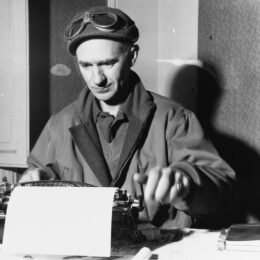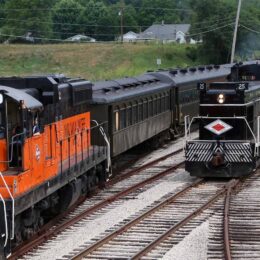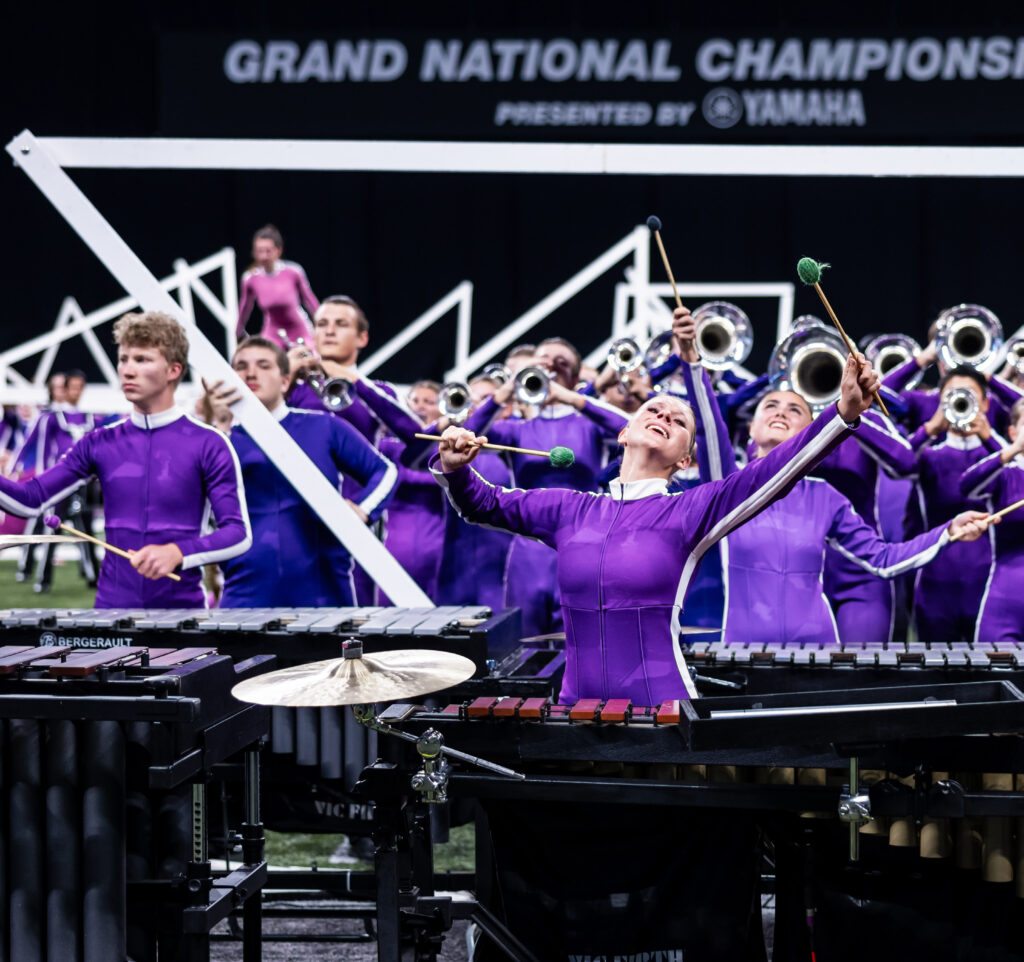
By Brian D. Smith
In 1984, Indianapolis opened a domed stadium and welcomed an NFL team. But the ex-Baltimore Colts weren’t the only out-of-state enterprise to find greener pastures in the Hoosier Dome’s (later called the RCA Dome) Astroturf. That November, the puffy-topped pigskin palace gained another major event when Illinois-based Bands of America (BOA) staged its Grand National Championships of high school marching band.
This month marks the 40th anniversary of Indy’s first Grand Nationals — and aside from a two-year stint at Michigan’s Pontiac Silverdome in 1987 and 1988, prompted by a scheduling snafu, this annual battle of the bands hasn’t left the city limits since.
But it has evolved, along with marching band itself in Indianapolis. Squads now perform beneath the retractable roof of the $720 million Lucas Oil Stadium, home of the Indianapolis Colts since 2008. And thanks to the four-decade presence of covered stadiums, situated in the interstate-rich Crossroads of America, Indy now hosts a triad of state, national, and international marching contests: the Indiana State School Music Association finals (for Hoosier high schools); the BOA Grand Nationals; and the DCI (Drum Corps International) World Championships for drum and bugle corps — all transpiring at Lucas.
The Grand Nationals, slated for November 14-16, add a $22 million punch to the local economy, having more than doubled their guest list over the past four decades. Whereas the 1984 event involved 49 high school bands, BOA now accepts as many as 110, and perhaps more, as 113 bands from 20 states had registered this year at the last count. Their localities range from north to south and from sea to shining sea — including Minnesota, Texas, Florida, Pennsylvania, and Washington, and in past years, even Alaska and Hawaii.
Should anyone doubt the significance of marching band in Indianapolis, take notice of the giant black curtain that stretches behind the performing bands, evoking the look of a black box theater. “Lucas Oil is the only stadium in the country designed with marching activity in mind,” said Deborah Asbill, executive vice president of marketing and communications for BOA.
Not surprisingly, the Grand Nationals attract an elite assemblage of past and present state champions and finalists, along with previous years’ finalists and winners of the Grand National Traveling Trophy, BOA’s championship award with a white enameled eagle on top. The bird currently roosts on Hoosier soil following Avon High School’s fourth Grand Nationals title in 2023.
Open to anyone
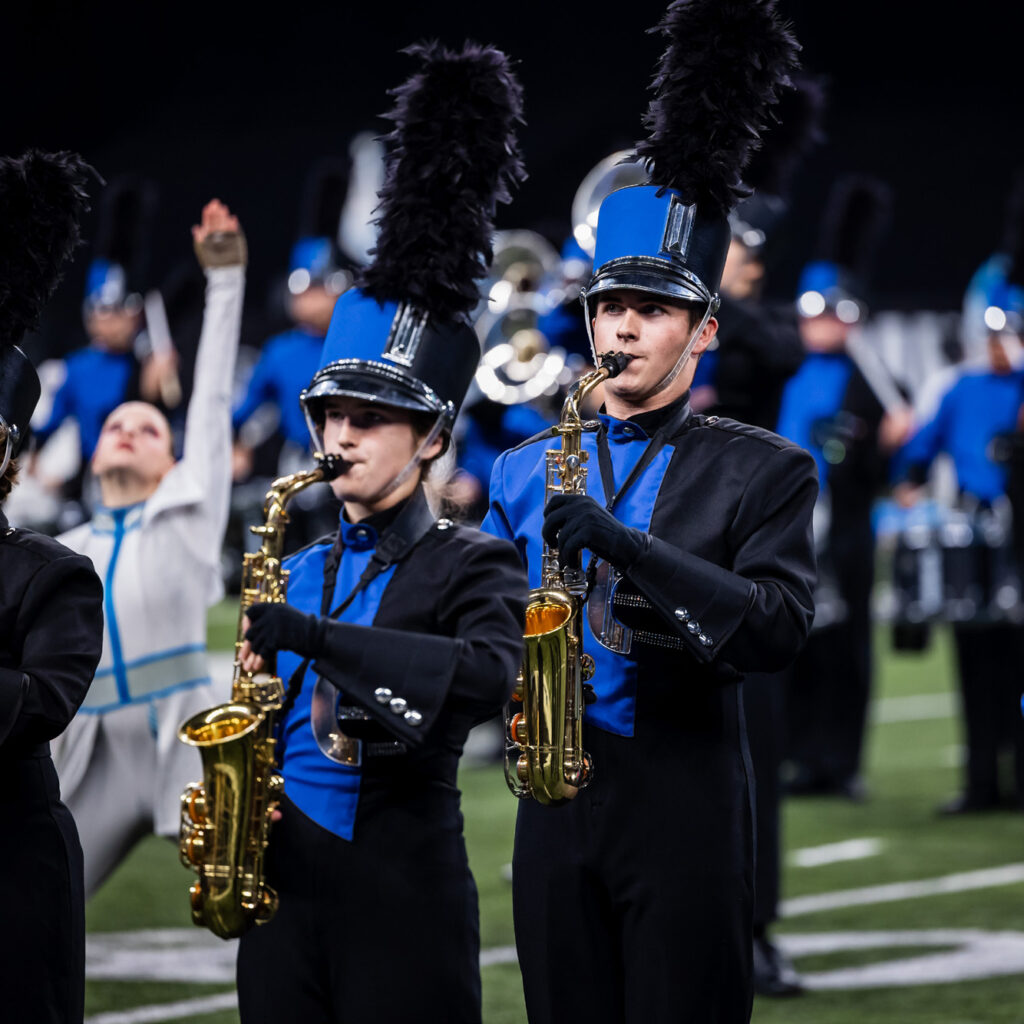
What’s more surprising are the qualifications for participating in America’s most prestigious high school marching contest. “There is the assumption that to be invited to the event, you have to be a state champion or a regional champion,” said Scott McCormick, president and CEO of the organization from 1984-2010 and the son of founder Larry McCormick. “But by design, Grand Nationals were created to be open to anybody.”
It’s easy to understand the misimpression. The BOA website lists a couple dozen regionals and three super regionals between September and November, which sound like prerequisites for the big bash. But in fact, these stand-alone competitions have no bearing on the Grand Nationals.
The simple truth about BOA’s annual extravaganza? “It’s open to the first 110 bands that register,” said Asbill. That’s why the 2024 lineup features bands as disparate as Carmel, a six-time Grand Nationals champion with an enrollment above 5,000, and 128-student Shawe Memorial of Madison. This Catholic high school didn’t even have a marching band before the current director arrived. But since both schools signed up and paid their $975 entry fee on time, they will each get their 6 to 11 minutes on the performance field as guaranteed by the adjudication handbook. Bands are divided into four enrollment classes — A, AA, AAA, and AAAA — but as with Indiana’s old single-class high school basketball tournament, the best of all sizes advance to the finals.
The open-to-all registration policy has been in effect since the beginning when Larry McCormick created Marching Bands of America (MBA) in 1975 as a subsidiary of his band supplies company, McCormick’s Enterprises. “He was a music educator heavily involved in drum and bugle corps growing up,” said Scott McCormick.
“He’d been a troubled teen and credited drum corps with changing his life.”
His “give-back” was to organize a four-day marching band festival in June 1976. Located at the University of Wisconsin-Whitewater, it offered seminars and workshops for students and band directors, culminating in the first Marching Bands of America competition for high schools. A $4,000 prize awaited the winner, along with the opportunity to represent MBA and its sponsor in major parades and festivals.
“It was conceived to be a national championship,” said Asbill. “We wanted to draw outstanding bands from across the country. That was not happening anywhere.”
Given that just 20 marching bands took part that first year, an observer might question whether the first “national championship” lived up to its billing. But the founder was undeterred by the turnout and returned to Whitewater in 1977. This time, 25 bands performed for a crowd of 8,200 spectators, while the educational programs drew 7,000 attendees. And so it went — until 1980 when organizers had to confront a nagging reality.
For many high school marching bands, June was perhaps the worst month to compete in a national championship. Last year’s seniors had departed, next year’s freshmen hadn’t arrived, and returning band members hadn’t performed on a football field since the previous October. “Not a lot of bands marched in the summer,” said Scott McCormick. “It was evident we needed to move into fall.”
And move they did, all the way down to the Gator Bowl in Jacksonville, Florida, marching on the Friday and Saturday after Thanksgiving. Two dozen bands appeared in the first fall Grand Nationals, after which the event spent three years inside the East Tennessee State University Mini-Dome, attracting 39 to 46 schools each year.
Then Indy proposed a long-term union, and BOA said yes. So the Grand Nationals moved in, and their 1984 Hoosier Dome debut was one of several seismic shifts the organization would undergo. That same year, Marching Bands of America would cease to exist as a subsidiary of McCormick’s Enterprises and reincarnate as a new nonprofit named Bands of America Inc. Larry McCormick would sell his company to an employee and relinquish the helm of the marching band operation to his son Scott, who became the first president and CEO of the new organization at the age of 23. “I didn’t want to see what he created go away,” said Scott McCormick, who acknowledged rookie mistakes but credited “good advisors and board members” with helping him keep BOA on track.
A diamond in the rough
The point man for Grand Nationals recruitment was Matt Carter, now chief destination development officer for Visit Indy (formerly the Indianapolis Convention & Visitors Association). At the time, BOA was based in the Chicago suburb of Schaumburg despite scheduling no events in that area. Carter quickly concluded that the organization was underappreciated in its existing location. “When I went up there to listen to them, I thought, ‘This is a diamond in the rough that Chicago doesn’t even know it needs to polish,’” he recalled.
Carter saw more than monetary benefit in bringing the Grand Nationals to Indy. Inspired by the book, “The Rise of the Creative Class” — which holds that creativity has replaced raw materials as the source of economic growth — he viewed the BOA championship as a conduit for the kind of young, creative people Indianapolis needs to attract. “Its primary benefit is they come here and bring talent from around the U.S. to our city every November,” he said. “The by-product is that we want them to come back and be a part of our community.”
As the 21st century unfolded, Carter and the city of Indianapolis returned for bigger game — Bands of America itself. They served up their 2003 pitch with a shot of sweetener: rent-free space at Union Station, where BOA headquarters remains to this day. Three years later, the organization reinvented itself again by merging with Music For All Foundation, a music education advocacy group, and becoming a subsidiary of the new Music For All Inc., whose outreach efforts also encompass choir, concert band, and orchestra.
In 2008, Indianapolis gained a world-class football stadium and marching band venue in Lucas Oil Stadium. By that time, another raiding party had already deployed to Addison, Illinois, luring Drum Corps International from the Windy City to the City of Indy. The DCI World Championships and their present-day $16 million economic impact came with it.
Known as “Marching Music’s Major League,” DCI differs from typical marching organizations in that it comprises of independent drum and bugle corps with names such as the Bluecoats, the Cavaliers, and the Boston Crusaders.
Originally inspired by military units during the post-World War I era, the modern drum corps consists of musicians 14 to 22 years old, none of whom carries a woodwind.
Although separate entities in the so-called marching arts, DCI and BOA have periodically collaborated over the years, notably at the 2023 Grand Nationals, when the Cavaliers’ percussion section gave a rousing exhibition during the semifinals.
Let’s hear it for the Hoosiers
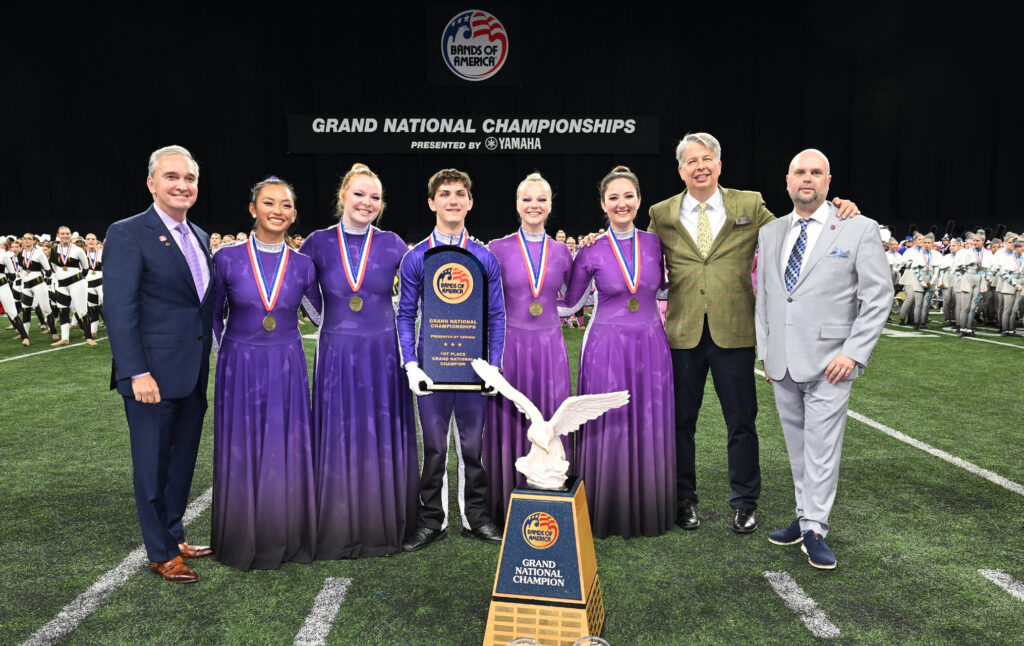
Last year’s Grand Nationals marked the second straight year that Avon and Carmel placed first and second. But the 2023 finish was a flip-flop of 2022 when Carmel claimed the crown
over Avon.
The Marching Greyhounds now count six overall championships and Avon four — impressive totals, to be sure, but still shy of the seven wins achieved by all-time leader Marian Catholic. The Chicago-area high school practically owned the trophy during the last half of the 1980s, with four titles in five years, but it hasn’t bagged the eagle since 2000.
If state pride matters, strike up a chorus of “Back Home Again in Indiana” for the 11 times in the last 20 years that Hoosier bands have taken the title, including Lawrence Central in 2004. Only two other states boast multiple triumphs since 2003 — Texas and Oklahoma, each with four championships.
Still, Texas put five schools in the finals last year compared to Indiana’s four. And in fairness, few bands located halfway across the country can afford to trek to Indy every year. The logistics of moving, lodging, and feeding a typical marching band of 100 to 300 members are so challenging that BOA has its own official travel provider, Music Travel Consultants of Indianapolis, to help schools handle such diverse tasks as booking charter flights, reserving rehearsal space, and arranging pre-finals meals. “Our origins are out of an understanding that travel is just uniquely different for bands, orchestras, and choirs because it requires so much movement of equipment,” said Bryan Munoz, assistant director of sales.
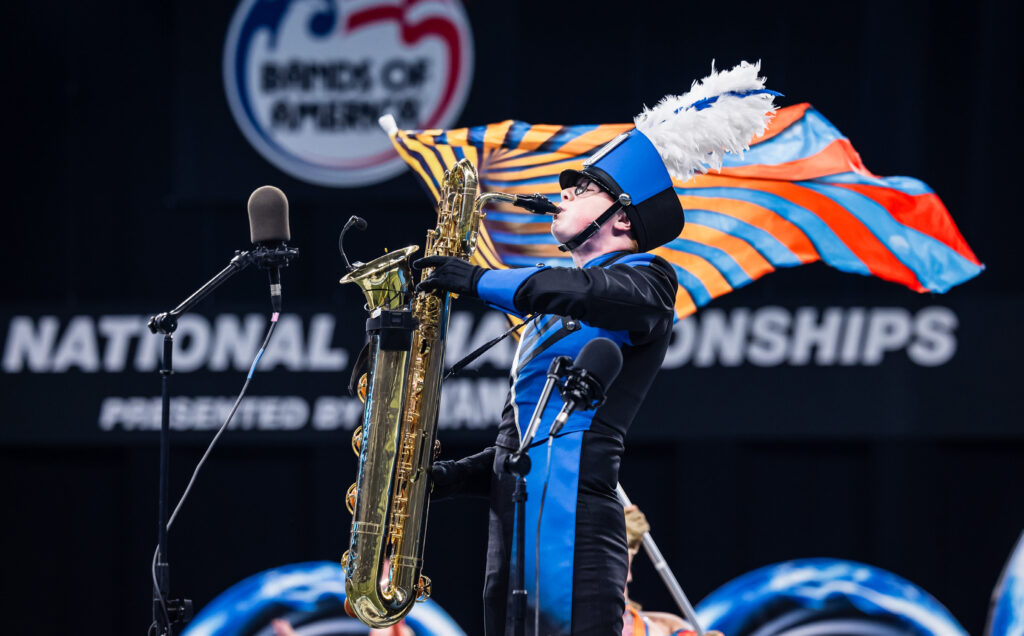
Providing memorable experiences
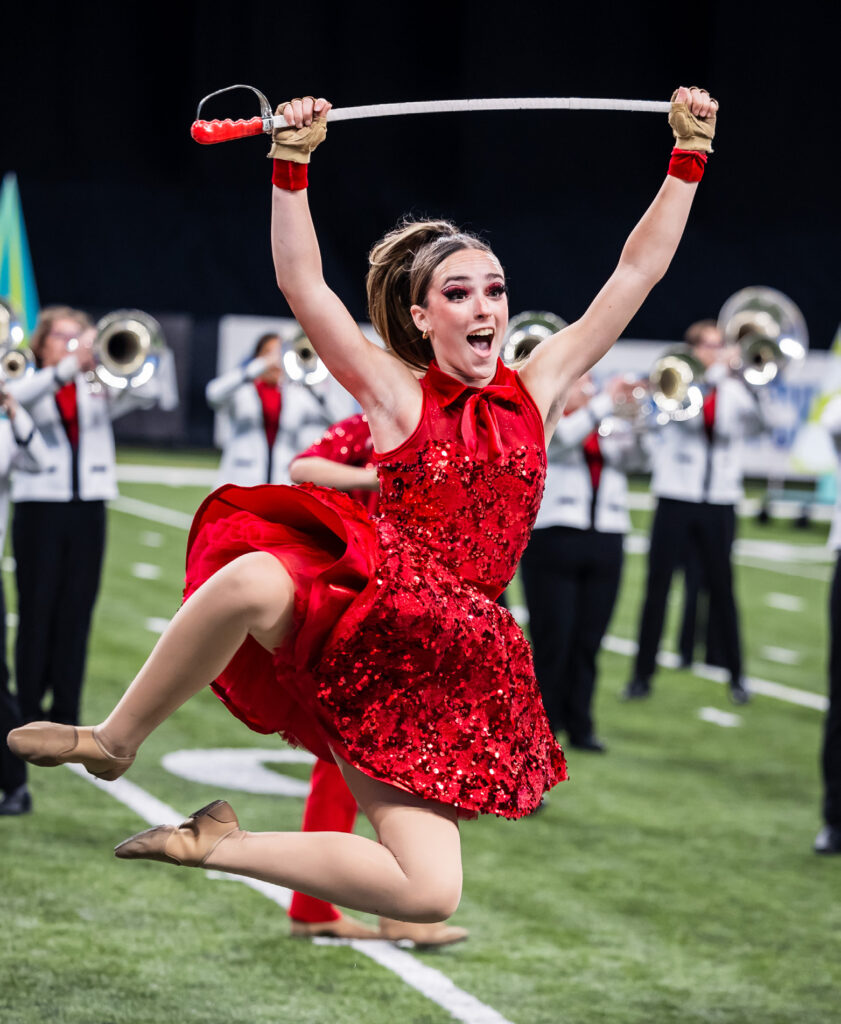
At Avon, success in the Grand Nationals serves as an unexpected recruiting tool, said performing arts secretary Cathy Klemmensen. “We have had four students move here from out of state just for the band,” she said, recalling how one boy’s parents showed up on enrollment day and asked, “Is this the only Avon High School in Indiana?”
Yet Matt Harloff, the band director of the defending national champion, has more on his mind than the eagle trophy. “Competition drives us for sure, but it’s not the No. 1 thing,” said Harloff. “No matter what happens competitively, our goal is to provide incredible and memorable experiences for our kids.”
Senior clarinet player Maddie McCleary remembers jumping up and down and crying tears of joy at the announcement of Avon’s victory.
But she also spoke of making friends with band kids from Ohio and Texas after the awards ceremony —
an opportunity born of longstanding Grand Nationals tradition. Once the championship trophy and other awards have been presented, the stadium announcer instructs the hundreds of band members from the 12 finalist schools to “Break ranks!” — cease standing in formation and mingle with their competitors.
Apparently, you can be a winner without winning anything at Grand Nationals. Tiny Shawe Memorial High School doesn’t have a football team, so it doesn’t have a football field. Its 43 marching band members practice in a parking lot behind the adjacent elementary school.
“We don’t have a chance of winning,” said band director Bill Gordon, whose crew finished 10th out of 26 in Class A two years ago. “But it’s still their favorite competition to go to. Walking onto the field, they’re in awe that they get to play there.”
And the awe doesn’t soon fade. Senior snare drummer Brody Haggerty marveled at how the “audience stands stretched out farther than your field of vision,” and the crowd seemed five times as big as any he’d ever performed for — “and it probably was, too.”
He isn’t about to wait until he has kids and grandkids to recount his memories of playing in the national marching band championship. Sunday NFL contests provide opportunity enough.
“Whenever I see a Colts home game on TV, I say, ‘I was there.’”
For more information on the Bands of America scoring system and to view past Grand National Championships performances, see below.
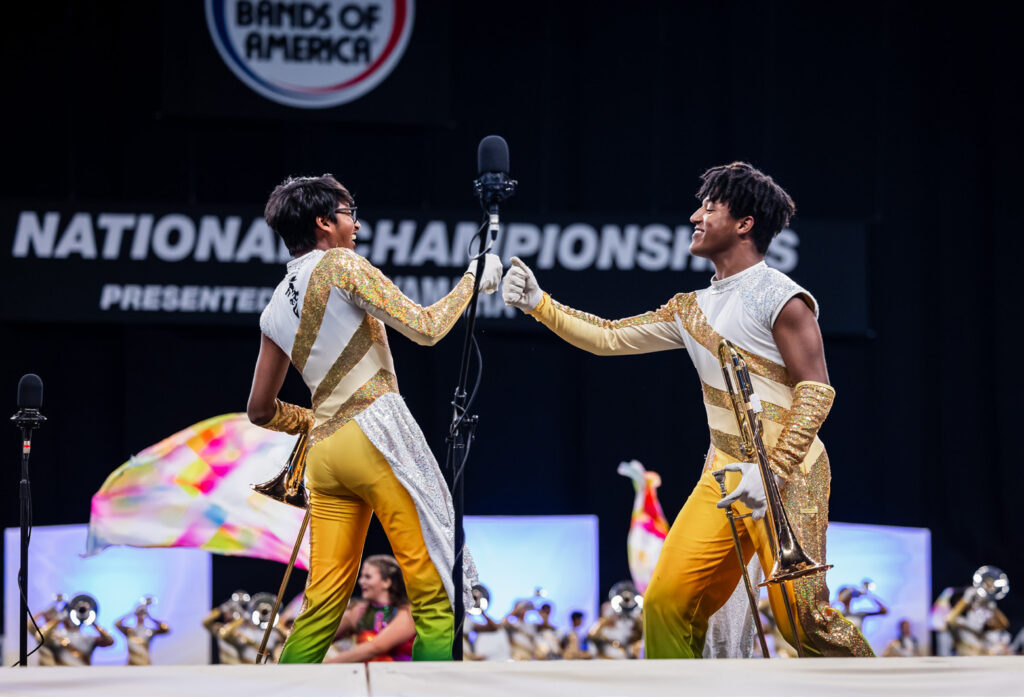
Maybe they should call it March Madness
There’ll be no shortage of madness about marching on Nov. 14-16, when thousands of high school
students from across the nation flock to Indianapolis for the 47th Bands of America Grand National
Championships. And if that’s the kind of musical talent show you would like to catch, it helps to
understand the game.
First, don’t expect to see “picture shows,” in which marching bands form recognizable objects on the
field. That’s a staple of college football halftime shows, as when the Ohio State University marching
band spells “Ohio” in flowing script or creates a moving jet fighter as a tribute to “Top Gun.”
Competitive high school bands, however, present intricate patterns and shapes that constantly transform
into new configurations. This movement is known as drill, and a Grand Nationals show can consume
100 to 120 pages, said Avon High School Band Director Matt Harloff.
The 113 bands on this year’s performance schedule represent a wide range of school size, band size,
abilities and resources. Participating high schools are divided into four classes from small to large —
A, AA, AAA, and AAAA — based on enrollment for the top three grades only.
The preliminary round takes place on Thursday and Friday, with half of the entries appearing each day.
The schedule doesn’t group schools according to class, so bands of various sizes perform as randomly
as the colors on a Rubik’s cube.
At least 30 bands (last year, it was 33) will advance to Saturday’s semifinals based on a formula that
ensures representation from all four classes. The 12 highest-scoring semifinalists, regardless of class,
earn a berth in the Saturday evening finals. While no band from Class A, the smallest enrollment
category, has taken the title since the two-class days of the late 1970s, a Class AA school, Tarpon
Springs, Florida, won it all in 2014. (See link below.)
Bands are graded on a 100-point scale, but so far, nobody’s perfect. Last year, it took a score of 90 to
reach the finals, 95 to make the top five, and 97 to crack the top two. Points come in performance
categories (Music Performance, Visual Performance, General Effect) and subcategories (Individual and
Ensemble), with some scores averaged together and others added together. BOA judges catch the action from ground level or a high vantage point. They assign bands a division rating of I, II, III, or IV based on their preliminary showing, but only the final point tally determines who advances to the finals.
Special note: In a first-ever exhibition, the marching bands of rivals Ohio State University and the
University of Michigan will perform jointly during BOA’s semifinal awards ceremony, which begins at
4:45 p.m. Saturday, Nov.16.
Pro tip: For a sampling of America’s best high school marching shows, search YouTube for “BOA
Grand Nationals.” We will get you started with these links to some of the most noteworthy.
- Avon, 2023. What does it take to be No. 1? Last year, Avon took home its fourth eagle trophy by
excerpting the stirring classical piece “Pictures at an Exhibition” and using frames as props.
https://www.youtube.com/watch?v=xGOjVaCPEug - Carmel, 2022. The Marching Greyhounds claimed their sixth Grand Nationals title — second only
to the seven by Marian Catholic of Illinois — with this show titled “Vitruvian,” a concept famously
depicted by da Vinci.
https://www.youtube.com/watch?v=Cz66rbzhzOM - Jackson Academy, 1993. Three decades ago, this tiny Mississippi band — which fielded only about
21 marching musicians, a dozen color guard members, and eight percussionists — made the Grand
National finals (they finished eighth) with one of the most original shows in BOA history. Watch
closely as color guard members suddenly begin marching with woodwinds, and male horn players
dance with color guard girls.
https://www.youtube.com/watch?v=CHBuNSQjK3A - Tarpon Springs, 2014. This Florida band pulled out all the stops — and the props — for its sci-fi
spectacular, “Man vs. Machine.” The theatrical thrust impressed the judges and earned Tarpon Springs the trophy, a rarity for a school in the second-smallest enrollment class.
https://www.youtube.com/watch?v=Yj96H4Gukrg - Vandegrift, 2019. Hoosier band fans meet the elite. Along with Avon and Carmel, this Austin, Texas,
school consistently ranks among the top three in the national ratings of the marching band website
HornRank. In their only Grand Nationals appearance, the Vandegrift kids played (and even sang) the music of Mozart and went home champions.
https://www.youtube.com/watch?v=9n1lFPz2IS8
Bonus: Ever wonder what it’s like to march in the Grand Nationals? This “drummer-cam” video
captures an insider’s view of the sights and sounds of Lucas Oil Stadium during Vandegrift’s postvictory encore presentation.
https://www.youtube.com/watch?v=rZWng5jbTgQ

